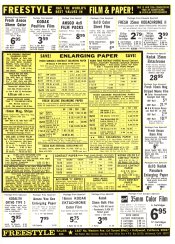tim48v
Partner

People sometimes think shooting film has gotten too expensive and long for the good old days. Here's my take on it:
https://shop.stearmanpress.com/blogs/news/who-said-shooting-film-was-expensive


I gave this some thought, Christopher but strangely enough despite not sleeping with you or paying your bills it still seems to matter to me.This entire conversation of film prices can be summed up in one simple sentence - "if you aren't sleeping with me, or paying my bills, what does it matter?"

Funnily enough I was browsing through an old copy of Black and White Photography magazine from December 2007 and some of prices caught my eye
It was an advert for Calumet. Tmax 100 in 120 was about £ 2.40 per roll as was Tmax 400 in 120 but the winner by quite some way was Acros 100 in 120 whose price was - wait for it - a jaw dropping ....£1.75
At the boring rate of inflation since 2007 and not the sort of exciting hipster way of comparing value with the big Mac, prices have risen in the U.K. by about 40% so Acros and TMax have of course risen in price. So any one fancy Acros for about £2.45 and TMax for about £3.36? Sounds good - even me.
Anybody found any Acros or TMax for anything close to those prices? I suppose value for money and whether anything is expensive relative to something else depends on the time period chosen and what the something else is. A big Mac may be an important economic measure of wellbeing in the U.S. or at least important for what the author believes is the market at which the article was aimed.
Maybe I need to adopt the kind of laid back spirit that brings a happy ending epitomised by the song Escape ( the pina colada song) by Robert Holmes. I have since discovered he was British born but he may have taken my laid-back genes with him
pentaxuser.
 Even if the per capita demand for film in the U.K may be be comparable to the U.S, there is simply less of us. Heck, by 2050 I think I'll be pouring my own plates. I hope the situation never gets to bad that I have to pick up a charcoal pencil!
Even if the per capita demand for film in the U.K may be be comparable to the U.S, there is simply less of us. Heck, by 2050 I think I'll be pouring my own plates. I hope the situation never gets to bad that I have to pick up a charcoal pencil! On a more personal note: Do you like pina coladas and getting caught in the rain and are you into yoga?
pentaxuser
The only arrow left in the quiver!I'd stock up on film. For all the printing of money the government is doing, inflation is going to double film's prices.
In old good days I was using few rolls of film per year. And potato was main food source for many. Nobody knew about french fries back then. It was not western world. One year they send us to collect potatoes and it was next to only food. I stopped eating potatoes after it for some time.
I started to use a lot of film in 2013. Kentmere bulks were 29 USD. Now it is 67 USD.
I guess, french fries prices also went up 2.4 times since 2013 as well.
I never been into junk food and now using less film.
I'm not that ambitious but film/gold ratio would be interesting too.
It wasn't uncommon in the period, that even the US Federal Reserve Bank calls "the Great Inflation", for people in the US to buy a Japanese car, and sell it 3 years later at 80-90% of what they paid originally. This was referred to as having a "better resale value" it was nothing more than the collapse of the dollar and the rise of the Yen. This is what spurred the building of assembly and fabrication plants in the US, especially in the southeast region of the US to take advantage of low cost labor.An interesting source for historical information is that books.google.com has a large collection of scanned issues of Popular Photography, with ads, for example here's Jan 1981: https://books.google.com/books?id=rzH31j84pn8C
In the US, official inflation was a factor of 6.6x from 1970 to 2019. Meaning that the price of both film and Big Macs has increased faster than official inflation, but only by a factor of 1.6x or so. The official inflation index includes a variety of goods and services, and some of those things probably got cheaper over time (eg electronics), more so than the cost of film manufacturing and distribution.
When you start comparing more specific things like price of Japanese-made goods in the US or UK at a specific time, then you get into exchange rate change (and sometimes tariffs). The number of JPY per USD fell by a factor of 2.5-3 from 1970 to 1990, and has been roughly constant since then. https://www.macrotrends.net/2550/dollar-yen-exchange-rate-historical-chart So it's not a surprise if Japanese-made film got more expensive.
indicator free stop bath on the fries please.
| Photrio.com contains affiliate links to products. We may receive a commission for purchases made through these links. To read our full affiliate disclosure statement please click Here. |
PHOTRIO PARTNERS EQUALLY FUNDING OUR COMMUNITY:  |